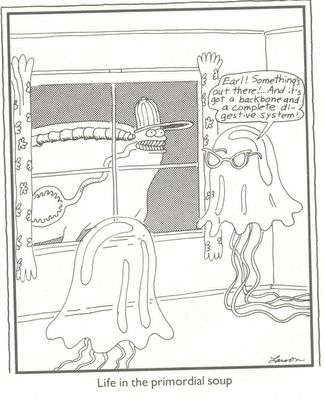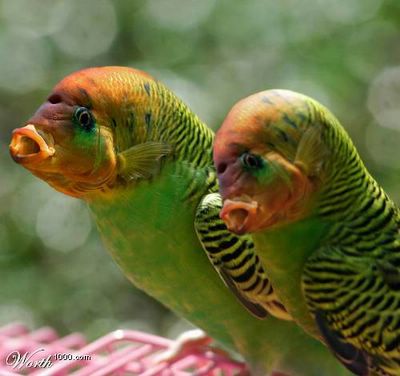This little fish (2 cm long) has independent eye movements like a chameleon. It is like a chameleon in many other ways, including unusual optics where the focal point of the eye in well in front of the centre of rotation....thereby generating monocular parallax cues by pure rotation of the eye without the need to make revealing translation movements of the head.There is a problem with this sort of continuity between disparate natural categories for Darwinists. Ironically, it is not the type of continuity that they need to write their mythological narratives of Naturalism.
Note also that both eyes move in alternation....a visible interhemispheric switch!(University of Queensland, Australia)
Although it is evidence of some type of commonality between different life forms it is not the sort of sequential commonality in common descent predicted by Darwinism and the "Tree of Life." The Darwinian prediction is that an organism can be traced back in a sequence from twig, to branch, to trunk, to root. The twigs on the tree can be quite disparate life forms, yet the prediction is that they can always be traced back into evolutionary pathways through other life forms, even back into a primordial pool as the ultimate common ancestor.

The problem with organisms like the sandlance for Darwinists, interesting little fellow that he is, is that he is a part of the empirical evidence that refutes Darwin's prediction of commonality at the root of life in common ancestry with more disparity and adaptation at the twigs. Instead what is observed empirically are these odd commonalities at the twigs as the sandlance and numerous other examples support the notion of a common design that seems to be designed to refute notions like Darwinism or the subpaganism of the ancient Asherah poles.
Although it is true that if you really want to put things in a sequence then you can arrange them in a sequence, gaps or no. Michael Denton notes in Evolution A Theory in Crisis that this is easier to do with bits of rock than it is with living organisms.
Interesting to think about what a helpful or harmful empirical observation would be for common design vs. common descent:

I suppose it depends on the order you consider things to have evolved given common descent. Don't laugh, there is not much reason that the duck billed platypus should have Mother Nature "select" its duck bill supposedly through the same environment in which other organisms do not have a duck bill "selected" by her. Other organisms have similar features which give evidence for a Designer's selections over Nature's "selections." How does the inanimate make a "selection" and why do Darwinists use such a term if they don't mean that it does?
At any rate, I think that tucan-fish would fall under evidence for common design, if it existed.
Inverted:


Fish-parrots....I know they'd certainly be counted as evidence for common descent by Darwinists. They count almost everything you can concieve of as such evidence, after all. Their heads would be labelled atavistic, etc. Unlike the incorrect sort of sequence illustrated in tucan-fish, the order is more in line with the Darwinian notion that birds have an ancestry in fish. Interesting to note, as some Darwinists count every piece of empirical evidence as evidence for Darwinism that they might argue that tucan-fish is ancestral to tucans. In a similar way, they might say that the sandlance is ancestral to the chameleon or that Nature somehow "selected" the same unlikely design twice or thrice in two or three different environments. It was not unlikely enough once?
No comments:
Post a Comment